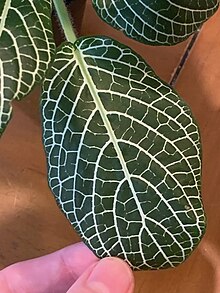Fittonia albivenis
| Fittonia albivenis | |
|---|---|

| |
| Scientific classification | |
| Kingdom: | Plantae |
| Clade: | Tracheophytes |
| Clade: | Angiosperms |
| Clade: | Eudicots |
| Clade: | Asterids |
| Order: | Lamiales |
| Family: | Acanthaceae |
| Genus: | Fittonia |
| Species: | F. albivenis
|
| Binomial name | |
| Fittonia albivenis (Lindl. ex Veitch) Brummitt[1]
| |
| Synonyms[1] | |
| |
Fittonia albivenis is a species of flowering plant in the family Acanthaceae, native to the rainforests of Colombia, Peru, Bolivia, Ecuador and northern Brazil. An evergreen perennial, it is notable for its dark green foliage with strongly contrasting white or red veins. It is commonly called nerve plant or mosaic plant. In temperate regions where the temperature falls below 10 °C (50 °F) it must be grown as a houseplant.[2]
Description[edit]

Fittonia albivenis is a creeping evergreen perennial growing to 15 cm (6 in) high, with lush green, ovate leaves, 7 to 10 cm long, with accented veins of white to deep pink and a short fuzz covering its stems. Small buds may appear after time where the stem splits into leaves. There are also forms in which the nervatura is carmine-red. Flowers are small with a white to off-white color.[3]

Cultivation[edit]
The species is used as an ornamental plant that requires fertile soils or substrates based on peat.[1] It is best kept in a moist area with mild sunlight, although it does not demand much light, and temperatures above 55 °F (13 °C). As such, in temperate locations it must be kept under glass as a houseplant.[citation needed]
It must be watered regularly. Without water for a few days, it is known to "faint" but is easily revived with a quick watering and resumes its healthiness. Fittonia albivenis is known to be hard to grow, so it is best bought at a nursery then cared for. Its spreading habit makes it ideal as groundcover.[citation needed]
Numerous cultivars have been selected, falling into two cultivar groups, the Argyroneura Group (formerly F. argyroneura, F. verschaffeltii var. argyroneura) with silver to white veins,[4] and the Verschaffeltii Group (formerly F. verschaffeltii) with pink to red veins,[5] both of which have gained the Royal Horticultural Society's Award of Garden Merit.[6]
Uses[edit]
The Kofan, Siona and Secoya tribes of the Ecuadorian Amazon use F. albivenis as a treatment for headaches,[7] and muscular pain, its leaves were used by the Machiguenga as a hallucinogen before they were introduced to Psychotria viridis.[8] They are said to "produce visions of eyeballs." The leaves of this species are prepared as a tea in the northwestern part of the Amazon region and used for toothache.[7]
See also[edit]
References[edit]
- ^ a b c "Fittonia albivenis". Germplasm Resources Information Network. Agricultural Research Service, United States Department of Agriculture. Retrieved 2008-02-25.
- ^ RHS A-Z encyclopedia of garden plants. United Kingdom: Dorling Kindersley. 2008. p. 1136. ISBN 978-1405332965.
- ^ Rob Herwig: Parey's Houseplant Encyclopedia . Edited by Richard Maatsch. Parey, Berlin / Hamburg 1983. ISBN 3-489-61024-5
- ^ "RHS Plant Selector - Fittonia albivenis Argyroneura Group". Retrieved 4 July 2020.
- ^ "RHS Plantfinder - Fittonia albivensis Verschaffeltii Group". Retrieved 27 February 2018.
- ^ "AGM Plants - Ornamental" (PDF). Royal Horticultural Society. July 2017. p. 39. Retrieved 27 February 2018.
- ^ a b "Plants". manu.montana.com. Retrieved 2008-02-25.
- ^ Russo, Ethan B. "Headace treatments by native peoples of the Ecuadorian Amazon". Universidad del Museo Social Argentino. Archived from the original on 2013-06-16. Retrieved 2013-05-19.
External links[edit]
- Fittonia albivenis (Verschaffeltii Group) Archived 2011-06-29 at the Wayback Machine
